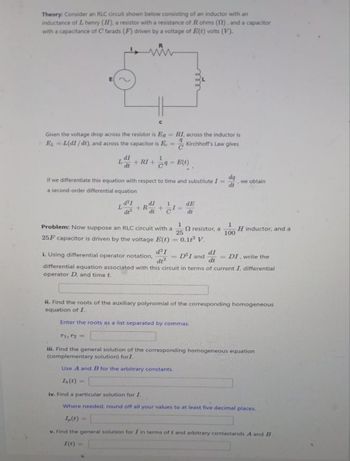
Introductory Circuit Analysis (13th Edition)
13th Edition
ISBN: 9780133923605
Author: Robert L. Boylestad
Publisher: PEARSON
expand_more
expand_more
format_list_bulleted
Question

Transcribed Image Text:Theory: Consider an RLC circuit shown below consisting of an inductor with an
inductance of L henry (H), a resistor with a resistance of R ohms (12), and a capacitor
with a capacitance of C farads (F) driven by a voltage of E(t) volts (V).
E
R
ww
Given the voltage drop across the resistor is ER
EL=L(dI/dt), and across the capacitor is E.
=
L
с
L +RI +9=E(t)
dI
dt
d²I
dt²
dq
dt
If we differentiate this equation with respect to time and substitute I = we obtain
a second-order differential equation
RI, across the inductor is
9
Kirchhoff's Law gives
C
dl
+R
dt
+ I=
dE
dt
1
Problem: Now suppose an RLC circuit with a 2 resistor, a
25
25F capacitor is driven by the voltage E(t) = 0.1t² V.
1
100
H inductor, and a
= D² I and
d² I
dI
i. Using differential operator notation,
DI, write the
dt²
dt
differential equation associated with this circuit in terms of current I, differential
operator D. and time t.
ii. Find the roots of the auxiliary polynomial of the corresponding homogeneous
equation of I.
Enter the roots as a list separated by commas.
71, 72=
iii. Find the general solution of the corresponding homogeneous equation
(complementary solution) for I.
Use A and B for the arbitrary constants.
In. (t)=
iv. Find a particular solution for I.
Where needed, round off all your values to at least five decimal places.
I, (t)
v. Find the general solution for I in terms of t and arbitrary contastands A and B.
I(t)=
Expert Solution
arrow_forward
Step 1: State the given data.
The differential equation of a series RLC circuit is given by
where
i. We need to write the given differential equation using differential operator, D and time, t.
ii. We need to find the roots of the auxiliary polynomial of the corresponding homogeneous equation of '
iii. We need to find the general solution for the corresponding homogeneous equation of '
iv. We need to find the particular solution for
v. We need to find the general solution of
Step by stepSolved in 7 steps

Knowledge Booster
Learn more about
Need a deep-dive on the concept behind this application? Look no further. Learn more about this topic, electrical-engineering and related others by exploring similar questions and additional content below.Similar questions
- Describe in words how the charges behave on capacitors which are in a parallel circuit. How do the individual capacitor charges compare to the charge of the equivalent capacitor?arrow_forwardthe equivalent impedance of a capacitor in parallel with an iductor is equivalent to an open circuit (i.e equal to infinity) at a certain frequency.Drive an expression for this frequencyarrow_forward.A series RLC circuit contains a 4-kN resistor, an inductor with an inductive reactance (X,) of 3.5 kn, and a capacitor with a capacitive reactance (Xc) of 2.4 kN. A 120-Vac, 60-Hz power source is connected to the circuit. How much voltage is dropped across the inductor?arrow_forward
- Please asaparrow_forward3. In an LC circuit, when the capacitor is maximum, the inductor energy is ........arrow_forwardA circuit is designed with an AC source of max voltage 12 and frequency 60 Hz. The circuit has a resistance of 1050 Ohms, an inductance of 0.06 Henrys, and a capacitance of 0.009 coulombs per volt. - omega for source in rad/s? - omegaR for circuit? -XL? -XC? -phi in radians? -Z? -imax?arrow_forward
arrow_back_ios
arrow_forward_ios
Recommended textbooks for you
 Introductory Circuit Analysis (13th Edition)Electrical EngineeringISBN:9780133923605Author:Robert L. BoylestadPublisher:PEARSON
Introductory Circuit Analysis (13th Edition)Electrical EngineeringISBN:9780133923605Author:Robert L. BoylestadPublisher:PEARSON Delmar's Standard Textbook Of ElectricityElectrical EngineeringISBN:9781337900348Author:Stephen L. HermanPublisher:Cengage Learning
Delmar's Standard Textbook Of ElectricityElectrical EngineeringISBN:9781337900348Author:Stephen L. HermanPublisher:Cengage Learning Programmable Logic ControllersElectrical EngineeringISBN:9780073373843Author:Frank D. PetruzellaPublisher:McGraw-Hill Education
Programmable Logic ControllersElectrical EngineeringISBN:9780073373843Author:Frank D. PetruzellaPublisher:McGraw-Hill Education Fundamentals of Electric CircuitsElectrical EngineeringISBN:9780078028229Author:Charles K Alexander, Matthew SadikuPublisher:McGraw-Hill Education
Fundamentals of Electric CircuitsElectrical EngineeringISBN:9780078028229Author:Charles K Alexander, Matthew SadikuPublisher:McGraw-Hill Education Electric Circuits. (11th Edition)Electrical EngineeringISBN:9780134746968Author:James W. Nilsson, Susan RiedelPublisher:PEARSON
Electric Circuits. (11th Edition)Electrical EngineeringISBN:9780134746968Author:James W. Nilsson, Susan RiedelPublisher:PEARSON Engineering ElectromagneticsElectrical EngineeringISBN:9780078028151Author:Hayt, William H. (william Hart), Jr, BUCK, John A.Publisher:Mcgraw-hill Education,
Engineering ElectromagneticsElectrical EngineeringISBN:9780078028151Author:Hayt, William H. (william Hart), Jr, BUCK, John A.Publisher:Mcgraw-hill Education,

Introductory Circuit Analysis (13th Edition)
Electrical Engineering
ISBN:9780133923605
Author:Robert L. Boylestad
Publisher:PEARSON

Delmar's Standard Textbook Of Electricity
Electrical Engineering
ISBN:9781337900348
Author:Stephen L. Herman
Publisher:Cengage Learning

Programmable Logic Controllers
Electrical Engineering
ISBN:9780073373843
Author:Frank D. Petruzella
Publisher:McGraw-Hill Education

Fundamentals of Electric Circuits
Electrical Engineering
ISBN:9780078028229
Author:Charles K Alexander, Matthew Sadiku
Publisher:McGraw-Hill Education

Electric Circuits. (11th Edition)
Electrical Engineering
ISBN:9780134746968
Author:James W. Nilsson, Susan Riedel
Publisher:PEARSON

Engineering Electromagnetics
Electrical Engineering
ISBN:9780078028151
Author:Hayt, William H. (william Hart), Jr, BUCK, John A.
Publisher:Mcgraw-hill Education,